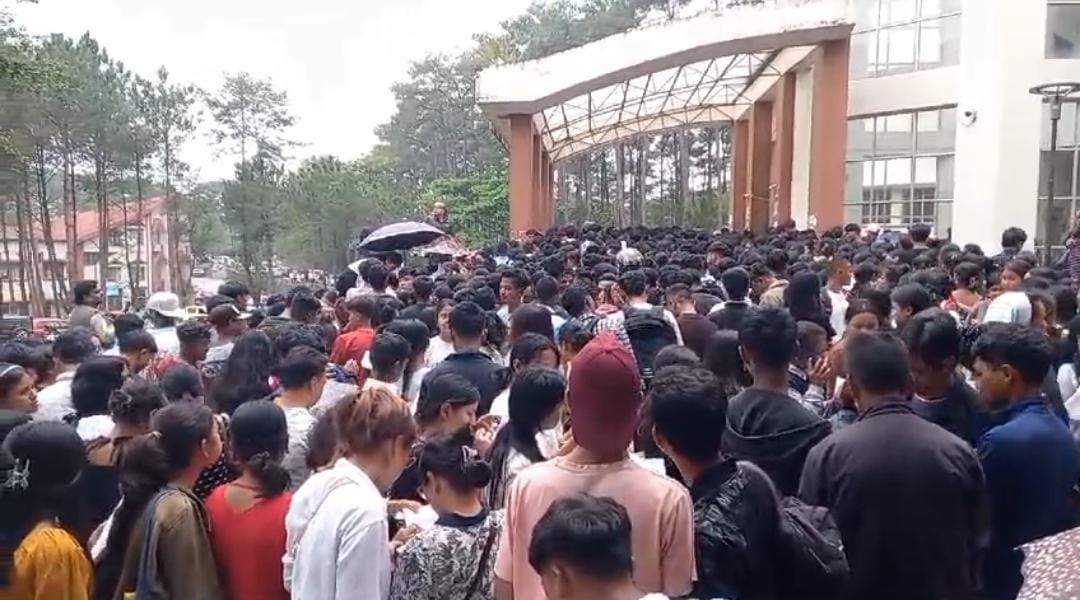Table of Contents
CUET experienced significant disruptions across two northeastern states after commencing on May 15. Miscommunication between the National Testing Agency (NTA) and North Eastern Hill University (NEHU) in Shillong caused chaos for about 3,700 students seeking undergraduate admissions.
CUET Chaos in Meghalaya: A Need for Competent Management

Image source: India Today NE
On May 15, 2024, students in Meghalaya encountered considerable chaos and exhaustion during the CUET exam, underlining a major organizational failure. Over 3,000 students at NEHU were affected by poor management. Instead of smooth proceedings, the process was marred by confusion from the outset, with mismanaged room allotments and biometric issues delaying the exam. The exam, scheduled to start at 3:00 PM, was delayed until 5:15 PM. Additionally, the rain and lack of clear instructions forced many students to miss their exams.
A NEHU teacher pointed out that inexperienced staff were a significant issue, calling for a more seasoned team in the future. This debacle suggests a need for serious introspection and better planning by the organizing committee. Teachers and parents are urging the government to consider this year’s CUET as a mock exam and to improve preparations for next year. Students are also pleading for college admissions based on their HSSLC results, fearing that the new system’s shaky implementation could jeopardize their futures.
Iaphilaniewkor Thangkhiew expressed these concerns in a letter to the editor of the Shillong Times via email, appealing for urgent and considerate action from the government.
Government’s Response to the CUET Fiasco

Image source: Syllad
Meghalaya’s Education Minister, Rakkam A. Sangma, stated that the state government is taking the CUET examination issues seriously. He mentioned that they would request the NTA to either re-conduct the exam or exempt Meghalaya from it altogether.
Sangma explained that the problems began when the NTA informed NEHU at 6 p.m. on May 14 that approximately 2,000 students would take the test. However, later that night, this number was updated to nearly 4,000 students.
“NEHU didn’t have sufficient time to prepare. Additionally, there was significant confusion regarding the exam centers, and there were inadequate setups to handle the biometric collection for hundreds of students,” Sangma stated.
Incidents of Chaos and Student Disadvantage

Image source: Highland Post
The chaotic situation led to a stampede-like incident, causing one student to faint and miss her test while others had to wait over two hours past the scheduled 3 p.m. start time.
“Many students performed poorly due to the chaos,” Sangma noted, emphasizing that students from rural areas were particularly disadvantaged as they were unable to register for the CUET.
Controversy in Assam

Image source: India Today NE
In Assam, the All-India Brahmin Front’s State Committee demanded action against Manas Chakraborty, the principal of Bhawanipur Regional College in Patacharkuchi, Bajali district, for allegedly offending religious sentiments. The principal reportedly asked Dhritiraj Vasishtha, a Brahmin candidate, to remove his sacred thread (janeu) before entering the exam hall. “We demand accountability and appropriate action against those responsible,” stated Pabitra Kumar Sarma, the front’s chief secretary.
CUET Examining Organizational Mishaps and Cultural Sensitivity

Image source: Syllad
The CUET debacle in Meghalaya and Assam highlights significant issues in the examination’s organization and implementation. The miscommunication between the NTA and NEHU led to severe chaos and confusion, impacting thousands of students. The government’s response and proposed actions reflect the urgency and seriousness of the situation. Furthermore, the controversy in Assam underscores the need for sensitivity and respect towards cultural and religious practices during such exams.
Moving forward, it is crucial for the organizing bodies to address these issues, ensure proper planning, and involve experienced personnel to avoid such incidents in the future. The voices of the affected students and the appeals from teachers and parents for fair and considerate measures must be heeded to safeguard the educational futures of the youth in these regions.




1 Comment
Pingback: Lok Sabha Elections 2024: A Comprehensive Overview - INPAC Times